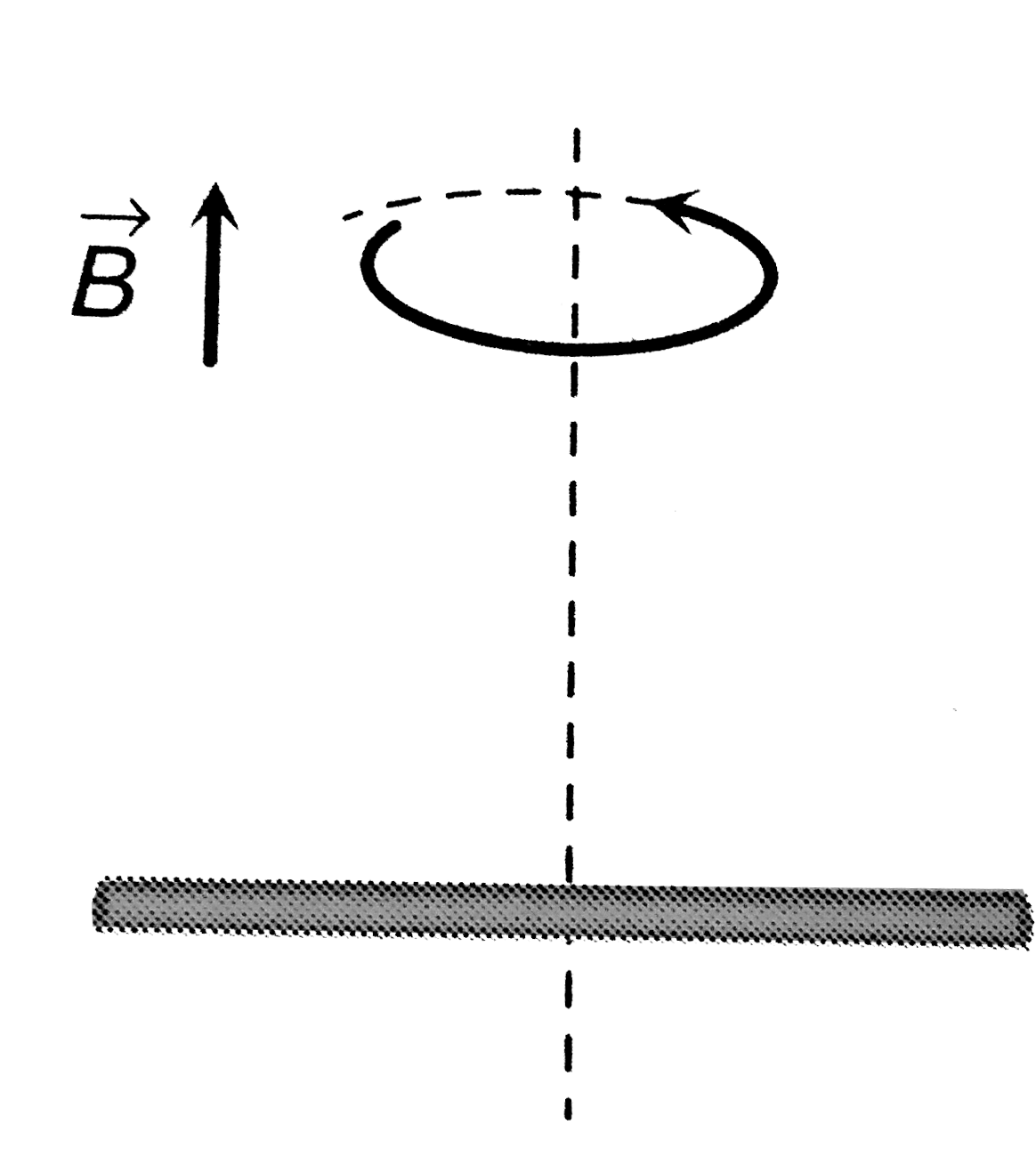A rod of length l rotates with a small but uniform angular velocity ω about its perpendicular bisector. A uniform magnetic field B exists parallel to the axis of rotation. The potential difference between the centre of the rod and an end is
zero
18ωBl2
12ωBl2
Bωl2
The correct Answer is:B
To solve the problem of finding the potential difference between the center of a rotating rod and one of its ends in a uniform magnetic field, we can follow these steps:
1. Understand the Setup:
We have a rod of length L rotating about its perpendicular bisector with an angular velocity ω. The magnetic field B is parallel to the axis of rotation.
2. Identify the Points:
Let’s denote the center of the rod as point C and one end of the rod as point A. The distance from the center to each end of the rod is L2.
3. Calculate the Linear Velocity:
The linear velocity v of a point on the rod at a distance r from the axis of rotation is given by:
v=r⋅ω
For point A (which is at a distance L2):
vA=L2⋅ω
4. Use the Formula for EMF:
The electromotive force (EMF) or potential difference V between the center C and the end A of the rod in a magnetic field is given by:
V=B⋅ω⋅Leffective
where Leffective is the effective length of the rod contributing to the EMF. Since we are considering the distance from the center to the end, Leffective=L2.
5. Substitute the Values:
Substitute Leffective into the EMF formula:
V=B⋅ω⋅L2
6. Calculate the Potential Difference:
The potential difference between the center C and the end A is:
VCA=VC−VA=B⋅ω⋅L2
Since we are looking for the potential difference between C and A, we need to consider the contribution of the entire length of the rod:
VCA=B⋅ω⋅L28
7. Final Result:
The potential difference between the center of the rod and the end A is:
VCA=B⋅ω⋅L28
We have a rod of length L rotating about its perpendicular bisector with an angular velocity ω. The magnetic field B is parallel to the axis of rotation.
Let’s denote the center of the rod as point C and one end of the rod as point A. The distance from the center to each end of the rod is L2.
The linear velocity v of a point on the rod at a distance r from the axis of rotation is given by:
v=r⋅ω
For point A (which is at a distance L2):
vA=L2⋅ω
The electromotive force (EMF) or potential difference V between the center C and the end A of the rod in a magnetic field is given by:
V=B⋅ω⋅Leffective
where Leffective is the effective length of the rod contributing to the EMF. Since we are considering the distance from the center to the end, Leffective=L2.
Substitute Leffective into the EMF formula:
V=B⋅ω⋅L2
The potential difference between the center C and the end A is:
VCA=VC−VA=B⋅ω⋅L2
Since we are looking for the potential difference between C and A, we need to consider the contribution of the entire length of the rod:
VCA=B⋅ω⋅L28
The potential difference between the center of the rod and the end A is:
VCA=B⋅ω⋅L28
Topper's Solved these Questions
- BOOK - HC VERMA ENGLISHCHAPTER - ELECTROMAGNETIC INDUCTIONEXERCISE - Objective 210videos
ELECTROMAGNETIC INDUCTION
- BOOK - HC VERMA ENGLISHCHAPTER - ELECTROMAGNETIC INDUCTIONEXERCISE - EXERCISE98videos
ELECTROMAGNETIC INDUCTION
- BOOK - HC VERMA ENGLISHCHAPTER - ELECTROMAGNETIC INDUCTIONEXERCISE - Worked out examples29videos
ELECTROMAGNETIC INDUCTION
- BOOK - HC VERMA ENGLISHCHAPTER - ELECTRIC FIELD AND POTENTIALEXERCISE - Objective 27videos
ELECTRIC FIELD AND POTENTIAL
- BOOK - HC VERMA ENGLISHCHAPTER - ELECTROMAGNETIC WAVESEXERCISE - Exercise8videos
ELECTROMAGNETIC WAVES
Similar Questions
A rod of length l rotates with a uniform angular velocity omega about its perpendicular bisector. A uniform magnetic field B exists parallel to the axis of rotation. The potential difference between the two ends of the lrod is
View SolutionA conducting rod of length 2l is rotating with constant angular speed w about its perpendicular bisector. A uniform magnetic field B exists parallel to the axis of rotation. The e.m.f. induced between two ends of the rod is
 View Solution
View Solution
Knowledge Check
- Question 1 - Select One
A rod of length l rotates with a uniform angular velocity omega about its perpendicular bisector. A uniform magnetic field B exists parallel to the axis of rotation. The potential difference between the two ends of the lrod is
ABl2ω2BzeroC(Bl2ω8)D2Bl2ω
A conducting rod of length 2l is rotating with constant angular speed w about its perpendicular bisector. A uniform magnetic field B exists parallel to the axis of rotation. The e.m.f. induced between two ends of the rod is
 View Solution
View SolutionA conducting disc of radius r rotaes with a small but constant angular velocity ω about its axis. A uniform magnetic field B exists parallel to the axis of rotation. Find the motional emf between the centre and the periphery of the disc.
View SolutionA metal rod length l rotates about on end with a uniform angular velocity ω. A uniform magnetic field →B exists in the direction of the axis of rotation. Calculate the emf induced between the ends of the rod. Neglect the centripetal force acting on the free electrons as they moving in circular paths.
View SolutionA straight rod of length L is rotating about an axis passing through O and perpendicular to the plane. In the space a uniform magnetic field B exits normal to the plane of rotation. Potential difference between a & b is equal to
 View Solution
View SolutionA metal rod of length 2 m is rotating with an angualr velocity of 100rads−1 in plane perpendicular to a uniform magnetic field of 0.3 T. The potential difference between the ends of the rod is
View SolutionA ring rotates with angular velocity ω about an axis perpendicular to the plane of the ring passing through the center of the ring.A constant magnetic field B exists parallel to the axis.Find the emf induced in the ring.
 View Solution
View SolutionA metallic rod of length l is hinged at the point M and is rotating about an axis perpendicular to the plane of paper with a constant angular velocity ω. A uniform magnetic field of intensity B is acting in the region (as shown in the figure) parallel to the plane of paper. The potential difference between the points M and N
 View Solution
View Solution
